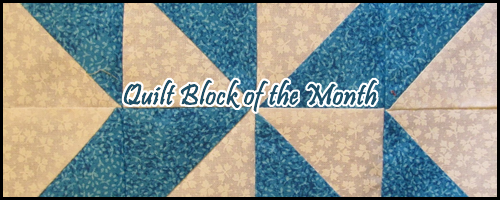Quilt Block of the Month - August 2018
Author: Elanda Tonil, August 2018
When most people in the northern hemisphere think of August, they often think of barbecues and swimming, not of making quilts. But it’s a great time for it! If you’re hoping to make a quilt for someone for the holidays, this is a good time to start working on it. But before all of that, our next block is a traditional block. There are oodles of variations on this block, and it’s simultaneously tricky and simple. This block is called a Log Cabin!
You can approach this block in quite a few different ways, I like the ripple effect here, starting light and getting darker as each layer was added. You can do anything you want as far as colors go. The most traditional is two colors, one on each half of the block split corner to corner, but if you google it, you can find a whole ton of great ideas for color schemes.
For this block you will have one center square, and twelve strips in your colors. I started with white, then had light, medium, and dark in each color. I’ll refer to them by these designations throughout but you can correlate them to match your pattern.
- Tips
- Square up as you finish attaching each strip and square up the entire block after each layer. Square up relative to your center square to ensure that each strip is straight and the layers don’t twist.
- You can press your seams in three different ways:
- Out, toward the darker fabrics. This will make it look like a ripple is spreading out, the outermost strips will have the emphasis. This will also minimize your seam bulk.
- In, toward the lighter fabrics. This will make the inner square stand out and look somewhat pyramid-like.
- Open, each side toward itself. This will make the block lay flat. It also puts the most strain on the fabric at the seams and creates some unexpected bulk when quilting.
- When pressing, I recommend pressing it flat before you press to your chosen direction. This is called “setting your seam” and it will minimize the puckering that is prone to show up in quilting. Some blocks encounter this more than others and this is one such block. In fact, this is something you will come across often with triangles as well as with strips, but setting your seams is a good habit to have, no matter what block you’re building.
- Fabrics
Center square: Cut 1 - 3.5” x 3.5” square
All colors: Cut 1 - 2” strip of each of your colors.
- Step 1
There’s no need to cut the strips into smaller pieces yet, we’ll trim the strips as we use them. Keep in mind, your lighter/center strips will be shorter so you can use smaller scraps for those ones. Your darker/outside strips will need to be 12.5” long so make sure your strip is at least 25” in length, though I would recommend giving yourself some extra wiggle room. Why cut it close if you don’t have to?
I like to lay out my fabrics to make sure I like the way it looks before I start sewing. If something really doesn’t work, I’d like to catch it now rather than a few hours down the line.
- Step 2
Pin your center square to the first of your light strips. If you have a crisp right angle on the edge, you can definitely line it up, I like to leave a bit of extra hanging over to make squaring it up simpler.
Sew along the edge, using a scant quarter inch seam.
Trim off the extra before you press it.
When pressing, I recommend pressing it flat before you press to your chosen direction.
- Step 3
After squaring up your square and first attached strip, you are going to sew your strips in a spiral around the center piece with the strip you’re attaching lying perpendicular to the strip you just placed.
Pin along the bottom edge and sew. Trim off the excess, then set your seam. Press towards the strip you just added. Square up the block relative to the center square. This will be your algorithm for the rest of the block.
Pin, sew, trim, set, press, square.
Be mindful of your fabrics. If you’re following my pattern, you will sew your fabrics light purple, light purple, light blue, light blue. The next tier is medium purple, medium purple, medium blue, medium blue. The last tier is dark purple, dark purple, dark blue, dark blue.
Second light blue.
First medium purple.
Second medium purple.
First medium blue.
Second medium blue.
First dark purple.
Second dark purple.
The dark blue is analogous… I forgot to take pictures of it…
Once you finish attaching the dark blue, all you need to do is square up your final block and then you have completed your Log Cabin!
Send any questions or comments you have my way, whether they’re about this block or anything else about quilting! I am always up for talking quilts.
